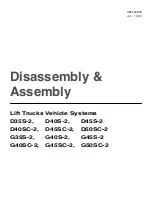
Operation Manual
40
Operator Cab
Operation Manual
40
Turn Signal and Hazard Switches
The optional Turn Signal Switch controls the turn signals
(toggle left or right). The optional Hazard Light Switch flashes
all four (4) turn signals (toggle up or down).
Steering Select Switch
The Steering Select switch has three (3) steering positions:
Crab, Two Wheel Steering (2W), and Four Wheel Steering (4W).
Figure 39. Steering Select and 2-Wheel Rear Switches
Warning
DO NOT change steering modes until the forklift slows
or comes to a complete stop. Align all four (4) wheels
perpendicular to the axle, before changing steering mode.
Changing steering modes at higher travel speeds can make
the forklift unstable, and cause a loss of control, which
could result in death, serious injury, or property damage.
Figure 37. Turn Signal and Hazard Light Switches
Figure 38. Rear Axle Centering Indicator
Rear Axle Centering Indicator
The Rear Axle Centering Indicator illuminates when the rear
wheels are aligned perpendicular to the rear axle. The rear
wheels must be aligned perpendicular to axle in order to
change the Steering Select switch. If the rear axle centering
indicator does not illuminate, stop the forklift, follow proper
shut down procedures, tag the forklift with “Do Not Operate”
tags, and have a qualified mechanic service or repair the
forklift
BEFORE
placing it into service again.
Declutch Indicator / Declutch Switch
The Declutch indicator illuminates when the Declutch switch
is set to the ON position. If the declutch indicator does
not illuminate, stop the forklift, follow proper shut down
procedures, tag the forklift with “Do Not Operate” tags, and
have a qualified mechanic service or repair the forklift
BEFORE
placing it into service again.
The Declutch switch (in conjunction with the service brake)
disengages the transmission to prevent the forklift from
moving while raising or lowering a load.
•
When the Declutch switch is set to ON and the service
brake applied, the transmission is disengaged.



































